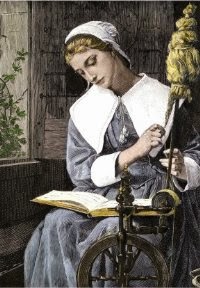Like many signers of the London Baptist Confession of 1689, Andrew Gifford had a wife. Her name, dates of birth and death, and other basic facts have at the present eluded me, but by looking at her husband’s life we can glance at a sliver of hers. Andrew was born in 1642, baptized in 1659 and began preaching in 1661. He also worked as a cooper (barrel maker and repairer), which would have produced a steady and comfortable living in a seaport. A son, Emanuel, was born in 1673, the sixth of nine children.
When Andrew was not welcome in churches due to the Act of Uniformity, he would preach in woods, fields, and homes. In 1677 he was ordained a pastor at the Pithay church in Bristol by the laying on hands of Daniel Dyk and Nehemiah Coxe. He was imprisoned four times, and an anecdote found in Joseph Ivemy’s History of the English Baptists concerning his fourth imprisonment in 1680 mentions Mrs. Gifford:
Providence seemed to give him intimation of his danger the night before his apprehension, which was so far from intimidating him, that it was a greater encouragement. His wife dreamed that he arose to go out to preach according to his appointment; but upon opening the door, the very first step he took was up to his knees in snow: that thereupon she dissuaded him, but in vain; that he was seized by two particular men, whose names she mentioned, and brought to the Sun Tavern, that then was without Lawford’s Gate, and there confined in a dining room, being placed behind a particular table in it; and one of them, by main force, held him down by leaning on his right shoulder and the other on his left. It made such an impression that she awakened with the fright, and told him of it, and did all she could to dissuade him. But he told her, she talked like one of the foolish women; that nothing should hinder him from his Master’s business. They arose, and upon opening the door to the yard, they found there had fallen a great snow since they went to bed, with a severe frost, that had driven up to the house, so that the first step indeed was up to his knees. Upon this she repeated her importunity, but to no purpose, and the result was that he was taken according to her dream, and every particular circumstance of it was the next day exactly fulfilled.
How much verity is found in this anecdote is uncertain.
Imprisonment did not seem to deter Gifford or cause him any fear. He and his two sons, Emanuel and Samuel, were involved in the Monmouth Rebellion of 1685 and were nearly caught when it failed. Yet providentially they escaped. As L.G. Champion states in his book Farthing Rushlight, “Andrew Gifford was a man of physical and spiritual vitality.” (p.2)
Andrew Gifford was known as “the apostle of the West”and ministered until his death in 1721. His son Emanuel followed in his footsteps and became a pastor. His grandson, also named Andrew, became a famous preacher as well. Not much may be known of Mrs. Gifford, but we can see that, surrounded by such men, her life must not have been boring.
Sources:
Barry, Jonathan and Morgan, Kenneth, ed. Reformation and Revival in 18th Century Bristol. Bristol Record Society, 1994.
Champion, L.G. Farthing Rushlight: The Story of Andrew Gifford 1700-1784. London: Carey Kingsgate Press Limited, 1961.
Crews, Ed. “Making Circles”, Colonial Williamsburg Journal, Autumn 2003.
Harrison, Frank. Mott. “John Bunyan and Andrew Gifford“, Baptist Quarterly. http://www.biblicalstudies.org.uk/pdf/bq/10-3_139.pdf (shows picture of Andrew Gifford between pages 140 & 141!)
Ivimey, Joseph. History of the English Baptists. https://archive.org/details/historyofenglish02ivim






